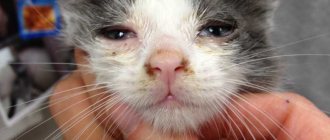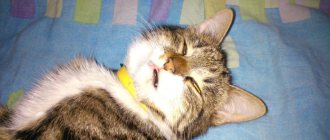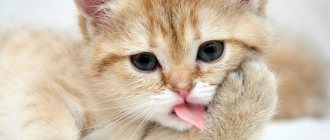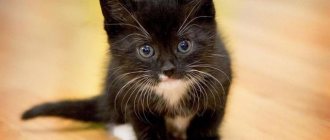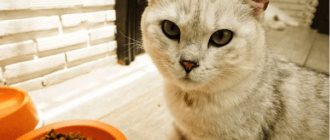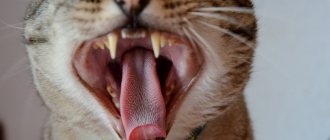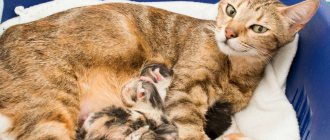Cats are capable of making a wide variety of sounds: from rhythmic purring and gentle meows to prolonged loud howls and snake hisses. The “sound background” depends on the physiological state and emotions, well-being and needs of the pet. Sick cats may cough, sneeze, wheeze, and sniffle. But sometimes the animal makes a sound when breathing, reminiscent of a short snore or grunt. What are the reasons for such a reaction? And is the “grunting state” dangerous to the pet’s health?
What causes a stuffy nose?
Pets are prone to infectious diseases, since they can often catch a cold while sitting on the floor or in a draft. If a cat has a stuffy nose, the reason may lie at the beginning of the inflammatory process. Only an experienced specialist can make a diagnosis. There you can also get recommendations on treating your pet.
Attention! If there is nasal congestion, then it becomes difficult for the animal to assess the surrounding environment, since this organ helps the pet navigate in space and recognize danger.
If a cat has a stuffy nose, he experiences a feeling of discomfort. Every owner is obliged to help the animal. Before starting treatment, it is important to determine the cause of this ailment, which may include the following:
- viral disease;
- the presence of parasites in the body;
- rhinitis, rhinotracheitis or sinusitis;
- hypothermia;
- rotting of the mucous membrane.
Some diseases can be cured on your own, but you need to focus on a well-made diagnosis. In order to cope with severe forms of disease, it is better to consult a veterinarian.
This is interesting: What kind of nose should kittens have?
Nose injuries
The nasal planum is an organ that provides the domestic predator with a significant amount of information about the surrounding world. When getting acquainted with something new, a cat carefully sniffs the object. She does the same with new pets or guests. By touching the owner’s hands and shoes and his things with his nose, the animal “reads information” about where the person has been, with whom he has been in contact, and what he has touched.
By sniffing food, the little hunter determines not only its freshness and edibility, but also its temperature. Injuries to the nasal planum are possible both in a pet that is allowed outside and in a couch potato.
A sore on a cat’s nose can appear after a fight with relatives, an unsuccessful jump from a height, or sniffing thorny indoor plants. Pets that live in the same house from a young age often do not perceive each other as links in the food chain. They play, communicate with each other, and not always neatly.
In case of a minor injury or ulcer on the nose, the cat can be treated by lubricating the nasal planum with vegetable oil, such as sea buckthorn or olive. A little tea tree essential oil is first added to olive oil (2-3 drops per 1 tsp), which improves wound healing and helps suppress the activity of microorganisms (bacteria, viruses, fungi). Before the procedure, you can lightly wash the wound by touching it with a cotton pad soaked in a pale pink solution of potassium permanganate (potassium permanganate).
If there is no effect from home treatment within 3-5 days, a veterinarian will help cure the small predator. Perhaps an infection has joined the injury or there is an allergic reaction to something.
Possible causes and most common diseases
You need to understand that in some breeds (brachycephalics), sniffing during sleep is considered absolutely normal due to the structural features of the muzzle. The only thing is that it is more difficult for them to recognize the symptoms of respiratory pathologies in time. In all other cats, such symptoms can be caused by the following reasons:
Foreign body. It's not often that something gets into a cat's nose, but even a small piece of fabric or thick paper can cause snoring and whistling when breathing. Almost always, owners manage to remove the source of irritation on their own. In rare cases (splinters, plant thorns), the participation of a surgeon is required.- Allergy. It has a huge number of varieties, but we are interested in contact dermatitis, which is characterized by the appearance of crusts in the nose that can cause wheezing when breathing. Food allergies usually include watery eyes, sneezing, swelling of the face, and various types of rashes. Contact dermatitis is characterized by nasal congestion and discharge, sneezing and itching. This reaction can be triggered by home flowers, household chemicals, or pollen from flowering plants (in pets with access to the street). Unfortunately, allergies are very difficult
Diagnosis and even more difficult to treat, so very often you have to resort to the method of excluding potential allergens. In some cases, the reason may even lie in the tray filler, after replacing which all symptoms gradually fade away. It is also recommended to limit animals’ access to household chemicals and detergents. - Growths. The most common formations found in the nose of cats are polyps. Their danger lies in the fact that they can cause overgrowth of the nasal passages, which will inevitably affect the general condition of the pet. At first, you may notice a slight sniffling through your nose during sleep or at rest. In the future, nasal discharge and an unpleasant odor may appear. The diagnosis can be confirmed using x-rays and rhinoscopy. In severe cases, an MRI of the entire head may be needed. The need for removal is determined only by the surgeon. Ideally,
polyps of any size should be removed and sent for histological examination. - Tumors. Most often malignant. Occurs in adults after 10 years. They are usually detected in the later stages, since the symptoms are very similar to many viral infections. At the initial stage, you may notice that the cat is sniffling through its nose. Subsequently, discharge and a foul odor appear. In severe cases, serious breathing problems begin, the nose bleeds, and the general condition rapidly deteriorates. With tumors everything is much more complicated (unlike polyps). For diagnosis, it is necessary to do a rhinoscopy, biopsy, MRI and CT scan of the head. X-rays are also indicated to exclude metastasis. Removal is only surgical with the capture of healthy tissue. In most cases, the prognosis is unfavorable due to
late detection and age of the animal. - Cat flu. Recently, it has become increasingly common even in young, vaccinated individuals. You can become infected from a sick cat or other animal carrier. The danger is that the mortality statistics are very high. But this is in the absence of treatment. At the initial stage, the disease affects the nasopharynx, which affects breathing - wheezing, whistling and gurgling appear. As the process progresses, pus begins to discharge from the nose. In advanced cases, the body temperature rises and the lungs are involved in the process. Treatment is strictly individual with the use of potent antibiotics. Much attention is paid to prevention, which includes disinfection of housing and all objects with which the sick animal has been in contact.
How to help your pet depending on the cause of sniffling and grunting?
After identifying the cause of these symptoms and making an accurate diagnosis, the veterinarian will develop a treatment plan. It requires an integrated approach. Therapy is aimed at improving the animal’s condition and relieving signs of the underlying disease. If a four-legged patient has a cough, antitussive drugs (Sinekod, Bronholitin) are used to eliminate it.
For dry cough, expectorant medications (ammonium chloride, Salbutamol) are indicated. When nasal congestion occurs, the nasal passages are washed with saline solution. To relieve inflammation, they resort to rinsing with chamomile decoction. When the listed remedies are powerless, it is recommended to instill any children's drops (Nazivin, Otrivin, Vibrocil).
The main treatment depends on the diagnosis:
- For helminthic infestations, a course of antihelminthic drugs (Milbemax, Stronghold) is indicated.
- When an allergy is diagnosed, its symptoms are relieved with antiallergic drugs (Suprastin, Tavegil). It is important to identify and eliminate the source of the allergic reaction, otherwise treatment will be useless, and attacks of this disease will appear again and again.
- For infectious diseases, antibiotics or antiviral agents are prescribed.
- Symptoms of heart failure are eliminated with the help of glycosides and potassium-containing medications.
- For injuries of the chest, spine, and ribs, immobilization, antibiotic therapy, and painkillers are indicated.
- For obesity, a diet is prescribed.
- Inflammatory diseases are treated with anti-inflammatory drugs and broad-spectrum antibiotics (Streptomycin, Erythromycin).
- When diagnosing asthma, glucocorticosteroids and bronchodilators are indicated.
Owners sometimes notice that their pet snores in his sleep, and when awake, his breathing seems labored, with hoarseness or wheezing. There are many reasons for this phenomenon, from the most harmless to the potentially fatal.
The structure of a cat's respiratory system is similar to that of a human. Between the nose and the lungs are the nasopharynx, bronchi and trachea. Breathing provides the entire body with oxygen and ventilation of the lungs from waste gases. If atypical sounds are observed during this process, it is necessary to show the animal to a veterinarian.
We invite you to familiarize yourself with Veracol for cats and kittens
Impaired respiratory functions can be caused by causes that are not directly related to diseases that have pulmonary pathogenesis (edema, fibrosis, pneumonia), but are no less dangerous for the pet’s life. Failure of gas exchange in the body can be caused by:
- brain and spinal cord injuries;
- an inflammatory process affecting the central nervous system;
- heart failure;
- foreign objects caught in the nasopharynx.
Associated symptoms of a serious illness will be changes in the animal’s behavior:
- passivity;
- loss of appetite;
- purulent or foamy discharge from the nose and mouth when breathing;
- pale blueness of the mucous membrane.
Contacting a veterinarian is mandatory and urgent.
Other reasons
When a kitten, cat or cat sniffles, but does not show signs of pain, behaves naturally, plays, and does not lose appetite, it is worth conducting an accessible examination of the animal:
- 1. If the pet’s mucous membrane has a healthy pinkish color, the body does not lack oxygen.
- 2. The absence of nasal discharge excludes colds.
- 3. Light pressure along the entire length of the back will help determine the presence (absence) of areas of pain.
Hoarse breathing can be caused by a deviated nasal septum or obesity, which is no more dangerous for a cat than for a person.
If your pet is wheezing, scratching, or sneezing, the disorder may be caused by an allergic reaction. This condition develops in pets due to:
- household chemicals;
- synthetic materials (flooring, wall decoration);
- stern;
- mineral toilet filler.
In this case, it is necessary to isolate the animal from the allergen. Antihistamines can be used, but should not be overused.
In addition to the well-known sneezing, cats sometimes begin to snort, wrinkling their noses, and rubbing their faces with their paws. Of course, such uncharacteristic behavior often worries owners: why does the cat sneeze and snort through its nose? Is this normal, or should I still see a doctor? Let's try to answer these questions.
If the cat rarely performs such actions and generally feels well, then most likely nothing needs to be done. Perhaps the cat simply inhaled the dust and successfully got rid of it on her own. But if the condition worsens and becomes painful for the animal, action must be taken.
We wrote about the technique of rinsing the nose in the article “What to do at home if your cat sneezes?” - This is the only thing that can be done before being examined by a veterinarian. The procedure will help get rid of foreign particles in the nose.
If the reason lies in deeper inflammatory processes, serious examination and treatment cannot be avoided, which is why it is so important to see a doctor.
What canned food tastes best for cats?
RESEARCH ATTENTION! You and your cat can take part in it! If you live in Moscow or the Moscow region and are ready to regularly observe how and how much your cat eats, and also remember to write it all down, you will receive FREE SET OF WET FOOD.
From time to time, cats can catch a cold and experience quite serious respiratory (breathing) problems. If you notice breathing problems in your pet, it is very important to promptly contact your veterinarian so that he can find out the exact cause of the airway congestion and prescribe appropriate treatment.
The cat sniffles: reasons
The causes of cat sniffing are divided into natural and pathological.
Natural ones include:
- increased physical activity - the number of inhalations and exhalations of animals is directly dependent on the degree of load on the body (a breathless animal may make uncharacteristic sounds, including sniffling);
- excitement, fear, anger, overexcitement - excited cats breathe frequently and noisily, which can occasionally be accompanied by wheezing (the described symptoms disappear immediately after the source of stress is removed);
- pregnancy, feeding kittens, sexual arousal;
- overheating (in this case, the pet breathes through its mouth, making a whistle and trying to sit on the floor in the coolest place);
- occasional sneezing.
Pathological causes include:
- swelling of the larynx due to swallowing inedible objects or allergies to food;
- asthma (in this case, the pet suffers from attacks of suffocation, accompanied by coughing and appearing both day and night);
- kidney stones (the disease is accompanied by hoarse breathing);
- helminthiases;
- diseases of the ENT organs, for example, bronchitis;
- heart failure (the animal’s mucous membranes become bluish, it coughs and wheezes);
- viral infections (in addition to wheezing, the pet may develop discharge from the nose and eyes, increase body temperature, and lose appetite);
- obesity (excess weight increases the load on the heart, which, in turn, is accompanied by shortness of breath and snoring);
- mechanical damage to the chest (in this case, the cat begins to stick out its tongue, its breathing becomes shallow).
Be sure to read:
A cat sneezes and snot: how to treat it at home, the causes of the disease, when it is considered normal
The nature of the sounds produced can indicate the location of the problem area:
- wet wheezing indicates accumulation of mucus in the respiratory tract;
- dry wheezing indicates swelling of the bronchi and larynx;
- crackling hints at the pathology of the pulmonary alveoli;
- A whistle indicates swelling of the airways.
The main causes of cat wheezing
If a cat sniffles when breathing through its nose, but there are no other signs of illness, there is no particular reason to panic. This symptom often indicates a runny nose or rhinitis. The inflammatory process that affects the mucous membrane of the nasopharynx usually develops against the background of severe hypothermia or a common cold. A runny nose in a pet also often occurs after a serious illness.
The following symptoms should alert owners:
- the cat sniffles while breathing, periodically scratches its nose with its claws, and snorts;
- the animal often sneezes, thick clear or cloudy mucus flows from the nose;
- the pet looks apathetic, lethargic, refuses to take food;
- signs of conjunctivitis are noticeable (the mucous membranes of the eyes are covered with purulent discharge);
- wheezing alternates with dull loud wheezing, the animal experiences shortness of breath and difficulty in the functioning of the respiratory organs;
- mucous membranes change color, become bluish, swelling is noticeable;
- The animal is rapidly gaining weight and becomes obese.
Normal cat condition
If your feline pet sniffles, but does not express any pain, his behavior has not changed, he plays, eats well, you need to examine the animal:
- if the nasal mucosa is pink, then the body receives enough oxygen;
- there is no discharge from the nose, which means a cold is excluded;
- Light pressure over the entire back will help determine whether there are or are no areas of pain.
Breathing with wheezing may be caused by a deviated nasal septum or obesity, which is not life-threatening.
When your cat sniffles, she also scratches her nose with her paws and sneezes; perhaps she just has an allergy, which will disappear after the allergen is eliminated.
We suggest you read why a cat behaves inappropriately
Treatment methods
There are situations when an animal suddenly stops breathing, the owner should know how to provide first aid. If breathing stops, an indirect cardiac massage must be started immediately. The cat should be placed on a flat surface in such a way that the line of the spine is straight.
Treatment is prescribed after the diagnosis has been clarified. If helminths are detected, anthelmintic drugs are given. Vitamin complexes are prescribed to maintain heart function. The cause of wheezing is determined by x-ray. Only proper treatment will quickly restore your cat's health.
Allergic reaction
If your cat has a stuffy nose and watery eyes, he may have an allergy. This problem can be encountered regardless of the age of the animal. It is imperative to identify the reason why such symptoms occur and eliminate the allergen, which can be:
- dust particles;
- household chemicals;
- mold formation;
- perfumes or aerosols;
- tobacco smoke.
Sometimes it is very difficult to rid an animal of complete contact with an allergen. For example, when the flowers begin to bloom, the kitten may experience discomfort. Breathing becomes difficult, and due to constant itching in the nose, the animal begins to sneeze.
If a cat has a stuffy nose and the pet is sneezing, then experts recommend giving him antihistamine-type drugs. The most popular drug is “Suprastin”, while an adult animal will need only a quarter of a tablet per day.
This is interesting: What to do if your cat has a dry nose
Calcivirosis
Calcivirosis is a dangerous viral disease of cats. In addition to the nose and oral cavity, the infection can affect the respiratory, hematopoietic and nervous systems of animals, and the digestive organs. The disease is often severe, with symptoms appearing within 1-3 weeks, and about a third of those affected die. Survivors are able to shed the virus into the environment for up to 12 months. With stress, deterioration of living conditions, infection with VLK or FIV, a relapse of calicivirus occurs. If a secondary infection occurs, the mortality rate increases to 80%.
To avoid death, you need to show the animal to a veterinarian as soon as possible.
Causes of nasal congestion in cats
Nasal congestion in cats is not an independent disease, but rather refers to signs of both mild ailments and serious and dangerous pathologies. The sense of smell is the most important sense for these animals, so if the first symptoms of a runny nose, difficulty breathing or excessive nasal discharge appear, you should consult a veterinarian. There can be many causes of the disease, but the most common are the following.
Cold
The most obvious cause of nasal congestion is, of course, a cold. A cat can catch a cold as a result of prolonged exposure to a draft or due to simple hypothermia. As a rule, in these cases symptoms such as general lethargy, weakness and tearfulness also appear. Sometimes the animal's eyes can even fester.
Viral or bacterial disease
Small kittens that have not yet developed a strong immune system are most susceptible to viral and bacterial diseases. At the same time, adults are also not immune from them. A cat can pick up the virus both during communication with unhealthy relatives and as a result of contact with contaminated objects: after sniffing outdoor shoes or rubbing parts of the body against them.
Only a doctor can identify a viral or bacterial disease
Viral infectious diseases found in cats:
- flu (cat);
- infectious rhinitis (the causative agent is most often the herpes virus).
Bacterial infectious diseases include:
- mycoplasmosis;
- pasteurellosis;
- chlamydia.
Only a correct examination will allow us to establish the cause of the disease and prescribe treatment, so the primary task is to diagnose the disease.
Allergy
Sometimes nasal congestion can be caused by an allergic reaction. Pedigree animals are more susceptible to various types of allergies. Most often, pets begin to snort and sneeze when in contact with:
- plant pollen;
- dust;
- hot steam;
- food;
- particles of household chemicals;
- flavorings.
If the consistency of the animal's nasal discharge is liquid and transparent, then most likely the cause of nasal congestion is an allergic reaction. A side symptom of the disease is watery eyes. In this case, it is necessary to identify the allergen and remove it from the living space. If you manage to guess and neutralize the provoking factor, then in the near future the cat will be able to feel significant relief. In addition, antihistamines can be used as an auxiliary measure for a speedy recovery of the animal (allowed to be used only after being prescribed by a specialist).
Parasite infestation
Nasal congestion and difficulty passing air through the respiratory system in cats can also occur as a result of infection with helminths - parasites whose habitats include the lungs of the animal. They can provoke diseases such as pneumonia and rhinitis.
Decreased immunity
With a weakened immune system, the animal is at greater risk of nasal congestion and runny nose. In this case, the cat will have a light-colored mucus discharge on his nose, and his body temperature will also increase. The pet will become lethargic, curl up in a ball and lie down, not even reacting to food.
Foreign body entry
Cats are active and curious creatures. This character trait increases the risk of injury during games - objects getting into the respiratory tract through the mouth or accidentally inhaling small pieces of grass and objects stuck in the nasal cavity. In this case, the animal may exhibit loud snoring and begin to wheeze and snort.
Important! If the pet is unable to independently remove the foreign body that is blocking the air supply, then snot along with blood may begin to come out of its nose. In this situation, the animal will need emergency care, otherwise tissue rot may begin, which will significantly complicate treatment.
Inflammatory processes
Inflammatory processes of the teeth and gums - chronic inflammation, the formation of polyps and adenoids in the nasal passages - can also lead to nasal congestion in cats. This is most common in Persian cats.
"Parasitic" problems
It is known that finding a cat that has not had helminths in its life is a task that is almost impossible in practice. It is extremely easy to “pick up” a parasite for a cat - he does not wash his paws with soap. On the contrary, our clean pets constantly lick their fur, to which anything can stick. For example, parasite eggs. Professional veterinarians generally recommend treating their pets with antiparasitic agents at least once a quarter, since otherwise problems cannot be avoided. Moreover, this must be done at intervals of two weeks...
Diseases caused by a virus
This infection can manifest itself in different ways, everything will depend on the body’s immunity. If a cat has a stuffy nose, loses appetite, has discharge from the eyes, and is generally lethargic, then one may suspect that the pet is suffering from a viral disease.
Sometimes other complications may be added to the symptoms already listed, so it is important to consult a doctor for treatment. Most often, Maksidin, Gamavit and Fosprenil are prescribed, which are used simultaneously. It is important to follow the recommended dosage.
Disease Prevention
Prevention of cat diseases includes:
- Rational, balanced nutrition. Lack of vitamins, microelements and nutrients necessary for the animal weakens the body.
- If it is not planned for cats to continue breeding, but to be kept only as a pet, sterilization (castration) is recommended. Sexual arousal negatively affects the health of animals, leading to congestion in the genitourinary system, fights and injuries.
- White individuals should not be allowed outside all day in the summer.
- Animals that participate in exhibitions or are kept free-range are recommended to be vaccinated. You must first make sure that your pet is healthy and not a virus carrier.
A healthy lifestyle includes minimizing stress. Affectionate, trusting communication with an animal not only maintains an emotional connection, but also strengthens the immune system.
Signs and types of wheezing
Wheezing is not just one sound. This is a whole combination of noise, each option corresponds to a specific group of pathologies.
Wheezing is usually classified into:
- wet;
- dry;
- crepitant;
- whistling.
Wet wheezing sounds appear due to the accumulation of mucus (phlegm) in the bronchi of the cat. Sputum is produced in large quantities as a result of inflammatory processes affecting the bronchial tree. The air inhaled by the animal passes through the mucus, bubbles form, which then burst. This is what causes wheezing. Moist rales are divided into small-, medium-, and large-bubble.
The first accompany the collapse of small bubbles formed by sputum. May occur with pulmonary infarction or bronchopneumonia. The latter resemble the sound of air blown through a straw. They occur when there is hypersecretion of mucus as a result of bronchitis, fibrotic changes in the lungs or pneumosclerosis.
The latter type of wheezing is clearly audible even without a stethoscope and occurs due to the accumulation of exudate in the lungs with a weak cough reflex or pulmonary edema.
Dry noises are divided into whistling and buzzing.
They arise due to narrowing of the lumen of the bronchi as a result of obstruction, mechanical compression by the tumor and the development of an allergic reaction. The air swirls and has difficulty squeezing through the narrow gap, which creates noise. When air passes through the unevenly narrowed bronchi, the sound becomes whistling. If there is viscous mucus in the bronchi, the mucous membranes block the path of air. And the breath passes with a slight buzzing sound, as if the air is squeezing through a narrow and half-covered hole.
Why is there a problem?
Cough is one of the main symptoms of rhinotracheitis in an animal.
If the kitten does not meow and its respiratory rhythm has changed, then in most cases the problem is associated with pathologies of the respiratory system. Many pulmonary diseases are characterized by copious secretion of saliva and mucus, which the pet often swallows. If a cat is breathing heavily and wheezing constantly, then this indicates a number of pathologies presented in the table.
| Disease | Short description | Additional symptoms |
| Rhinotracheitis and calcivirosis | The mucous membranes of the respiratory tract and intestines become inflamed | Heat |
| Diarrhea | ||
| Cough and severe wheezing | ||
| Ulcers on the mucous membranes | ||
| Purulent and mucous discharge from the eyes and nose | ||
| Pneumonia | Inflammatory reaction in the lungs associated with viruses and bacteria | Barking type cough |
| Temperature increase | ||
| Deterioration of general condition | ||
| Bronchial asthma | Chronic inflammation of the airways with narrowing of the pulmonary lumen | Frequently pressing the cat to the floor |
| The animal is breathing hoarsely and coughing | ||
| In advanced cases, the pet suffocates | ||
| Helminthiasis | Associated with the entry of small parasites into the respiratory tract | Vomiting and nausea |
| Breathing with wheezing | ||
| Broken stool | ||
| The pet eats almost nothing | ||
| Cancerous tumors | Accompanied by the proliferation of malignant cells in the respiratory organs | The cat grunts and sniffles when it breathes |
| Changed voice, and sometimes meowing disappears completely | ||
| Shortness of breath and cough with bloody impurities | ||
| Laryngeal edema or laryngospasm | Occurs against the background of poisoning with household chemicals, an allergic or autoimmune reaction | Acute lack of oxygen |
| Restless state | ||
| The cat meows hoarsely and moans often |
The animal may experience difficulty breathing due to the triplication of the skull.
- foreign body entering the throat;
- brachycephalic syndrome;
- pulmonary edema;
- congenital anomalies;
- tracheal collapse.
When a cat has hoarse breathing accompanied by a loud sound, this does not always signal a pathology in the respiratory system. Often a cat grunts and breathes through his mouth due to the following disorders:
- Protrusion of the diaphragmatic hernia. The symptoms are reminiscent of bronchial asthma, with the pet constantly being in one position and breathing heavily.
- Heart diseases. In case of heart failure, the animal rarely develops a cough, and the cat often wheezes and breathes through his mouth. Arrhythmia, myocardosis and myocarditis can affect impaired breathing.
- Severe renal failure. The pathology often provokes pulmonary edema, as a result of which the pet refuses to eat, is constantly in a semi-sitting position and coughs.
Foreign bodies
Just like a person, a cat may well choke while eating. Sometimes a couple of minutes are enough for him to cough properly, but sometimes an unsuccessfully swallowed piece of food can end up in the lumen of the respiratory tract. This is fraught not only with the development of “grunting” breathing, but also with something more serious, including the possibility of death from suffocation.
If your cat suddenly starts grunting, wheezing and coughing immediately after eating, call the vet immediately! Even in mild cases, when a foreign body only partially blocks the lumen, all visible mucous membranes of the pet quickly turn blue and become engorged with blood . The result is death from suffocation or severe pulmonary edema . Of course, you can try to remove the foreign body yourself, but in cases where you do not have the appropriate veterinary or medical experience, you should not do this. You will only aggravate the pathological process and possibly injure the animal.
Unfortunately, pieces of unsuccessfully swallowed food are not the worst thing. A similar clinical picture can be caused by tumors, not only benign, but also malignant . Grunting in such cases develops gradually. Neoplasms, as a rule, take a long time to grow, and therefore owners may not attach much importance to the pet’s strange behavior.
Thus, all the strange sounds that your cat begins to make are a reason for an immediate visit to the clinic. Perhaps in this way you will save his health and even his life.
Caring for a sick animal
Many people are faced with the question of what to do if a cat has a stuffy nose. First of all, take care of peace so that the animal is warm and in a comfortable place. Be sure to give as much water as possible. Sometimes to do this you have to force the cat to drink using a syringe. Even if this does not help, then use a saline drip, since dehydration can occur very quickly. It is important to give soft food during illness.
Possible diseases and pathologies
When your pet snores constantly, or very often, it may be a symptom of one of the following conditions:
- swelling of the larynx; may be caused by allergies, or the presence of foreign objects in the respiratory system;
- urolithiasis disease; snoring is sometimes accompanied by wheezing;
- the presence of worms, which may even be present in the respiratory system;
- asthma;
- rhinitis;
- pneumonia and bronchitis;
- heart failure; along with wheezing, a cough and blue discoloration of the mucous membranes can be observed;
- respiratory tract infections;
- obesity.
A veterinarian will help the owner determine the cause of wheezing when breathing in a cat.
Treatment of rhinitis or sinusitis
Due to severe hypothermia, problems sometimes arise; you may notice that the cat has a stuffy nose, what to do in such a situation. If this does not develop into a chronic stage, then you can get rid of the disease at home. The following treatment options are acceptable:
- Give the animal "Dioxycycline" according to the instructions.
- Rinse your nose with saline solution.
- Treat your sinuses with sea buckthorn oil.
- Use drops of furatsilin solution.
- Place bags on your nose and place warm salt in them.
Very rarely, antibiotic treatment is used in this case. In order for your pet to recover faster, you need to take care of its comfort. It is also recommended to give him plenty of regular warm water.
Diagnosis and treatment
Periodic snoring is normal for humans and animals. If this happens rarely, it should not be a cause for concern. But if it's a cat sniffling while breathing all the time, or even breathing with its mouth open, it should be a cause for concern. Persistent breathing problems can lead to more serious health problems. Most likely, you will need a veterinarian's consultation and treatment, because... It is difficult or even impossible to independently determine the disease. But before contacting a doctor, it is necessary to observe an animal that is sniffling and breathing heavily. To make a diagnosis, exclude various diseases and prescribe the correct treatment, the doctor will need detailed information.
The veterinarian may ask for the following information about a cat who wheezes when he breathes::
- the age of the animal and its lifestyle;
- weight and its relationship with the norm for a given breed;
- how long ago did the wheezing occur?
- Are there other sounds heard when the cat breathes?
- changes in the color of mucous membranes;
- the presence of various injuries (torso, nose, mouth, larynx);
- changes in behavior (low activity, weakness, excitability);
- other symptoms (digestive problems, vomiting, other breathing problems, cough, runny nose, sneezing).
If your cat is breathing poorly through his nose and sniffling, you should not wait for this to go away on its own. Such signs may indicate a serious illness in a cat or kitten that requires immediate treatment.
The nature of the snoring and sounds can often roughly determine the source of the disease.:
- wet rales indicate the presence of phlegm in the respiratory organs;
- dry wheezing indicates the presence of swelling in the bronchi or throat;
- crackling – there may be problems in the alveoli;
- A whistling sound may indicate swelling in the respiratory tract.
Only a qualified specialist should diagnose and prescribe treatment for a cat that wheezes when it breathes. Independent choice of treatment method and incorrect diagnosis of the disease can lead to a significant deterioration in the animal’s condition.
Only timely initiation of treatment and the correct choice of medications can ensure a quick and complete recovery of the pet. You should not rely on the recommendations of other cat owners from forums - each case is individual, even with similar symptoms.
A cat sniffles when breathing: what to do, why they sniffle when breathingLink to main publication
The reason why a cat snores loudly when breathing
The respiratory system of cats is similar in structure to that of humans. They, just like humans, can sigh, grunt and even snore. If a cat sniffles not only in his sleep, this may be a symptom of an illness.
If you don’t understand why your cat wheezes when breathing, then most likely she has rhinitis or a runny nose.
The animal begins to sniffle as a result of inflammation of the nasopharyngeal mucosa. This happens due to hypothermia or a cold.
The respiratory system of cats is similar to humans
A pet's runny nose often occurs as a result of exposure to chemicals. Rhinitis can be a consequence of any previous disease.
If a cat sniffles, you need to monitor it; the sick pet constantly rubs its nose with its paws, often sneezes, and has difficulty breathing.
In addition, the pet looks apathetic, there is exhaustion, and the development of conjunctivitis.
In case of a cold or rhinitis, treatment must be carried out to avoid negative consequences.
When to take your cat to the vet
If your cat sniffles frequently or breathes with her mouth open, this should alert you and cause a visit to the veterinarian. Before consulting a doctor, you need to observe the animal for a couple of days in order to correctly answer questions at the veterinary clinic to make the correct diagnosis. The veterinarian may be interested in the following information:
- how long ago did the snoring begin?
- are there any accompanying sounds along with wheezing during breathing;
- whether the pet was injured;
- whether the animal’s usual behavior has changed;
- was there a change in the color of the mucous membranes;
- other symptoms (vomiting, runny nose, cough).
Persistent breathing problems can cause more serious health problems.
By the nature of snoring and additional sounds, you can determine the source of the disease:
- wheezing, coughing and blue mucous membranes signal heart failure;
- wheezing and wheezing indicate the presence of urolithiasis;
- wet rales may indicate phlegm in the respiratory system;
- crackling indicates problems in the alveoli;
- dry wheezing indicates the presence of edema in the bronchi or larynx;
- sniffling plus whistling may indicate swelling in the airway area.
When your pet has difficulty breathing and sniffles, do not make a diagnosis yourself, this can lead to her death.
A correct diagnosis and timely initiation of treatment will ensure a speedy recovery for the cat. There is no need to rely on the advice of other cat owners or information on websites. Each case is individual, even if the symptoms are similar.
Pathologies and diseases that are accompanied by snoring
Usually, wheezing in the absence of other signs of illness does not cause discomfort to the pet. If the breathing problem does not go away, the pet regularly sleeps with its mouth slightly open, it is better to immediately contact a specialist - the veterinarian will conduct the necessary studies, tests, and prescribe the necessary treatment.
The main diseases accompanied by wheezing when breathing:
- Swelling of the respiratory tract. The main symptom is a loud or muffled whistle when inhaling air.
- Heart problems. The main symptoms are severe blueness of the mucous membranes and a deep cough.
- Swelling of the bronchi and larynx. This pathology is indicated by dry wheezing, which often turns into prolonged coughing attacks.
- Accumulation of mucus in the respiratory tract. Wet wheezing, mucus discharge from the nose, severe shortness of breath.
- Urolithiasis. Alternating loud, prolonged wheezing and sniffling, loss of appetite, meowing during urination are the main signs that should prompt an immediate visit to a veterinarian.
Infection with worms also often causes problems with the respiratory system of a pet. Particles of parasites are visible in the feces, the animal quickly loses weight, looks exhausted and lethargic.
If a cat wheezes while breathing while sleeping, there is no particular cause for alarm, but it is better for the owners to carefully observe the pet for several days - this will allow timely detection of other signs of hidden diseases. It is not recommended to use any medications or home remedies on your own, relying on the advice of friends or information on thematic forums. Each case is individual and requires specific treatment, which is possible only after an accurate diagnosis.
What to do to help your pet
First of all, in order not to worsen the situation, it is worth consulting a specialist about the probable disease. Treatment is most often complex. If a cat has a stuffy nose and the cause is rhinitis, then antibiotic therapy is most often used. However, only the doctor chooses the drug!
For nasal congestion, anti-inflammatory medications are often prescribed; those that help reduce fever are also prescribed; vitamins are also included. If there is a strong flow from the nose, then the use of special drops is recommended. Again, under the supervision of a doctor!
If a cat has a stuffy nose, how to treat it? Only an experienced veterinarian can give the answer. Folk remedies include the use of inhalations with ethers and the use of warm compresses. You can also rinse your nose with aloe juice; the benefits of this plant are already widely known.
It happens that crusts form on the muzzle; they must be removed; to do this, you will need to use a cotton swab dipped in water. If the mucous membrane is too dry, then you should lubricate the nose with cream, you can use oil.
Preventive measures
In order to protect the animal, it is necessary to provide it with the necessary care. The cat's body can overcome many diseases on its own if it has a good immune system. Therefore, it is important to adhere to certain rules:
- Make sure your pet eats a balanced diet and gets all the necessary vitamins.
- If your pet has access to the outdoors, it is important that he does not stay in the cold or damp for a long time.
- If there is a sick animal in the house, it must be separated from the rest to prevent infection.
- Regularly perform eye, nasal and ear hygiene.
- Closely monitor your pet's behavior and respond to changes in behavior.
- If you suspect that your cat is sick, be sure to contact a veterinarian.
- Monitor the condition of the animal’s sleeping place, bowl and tray.
If, despite all efforts, the cat still gets sick, then it is better not to try to cure it yourself. You can carry out the procedures at home, but only strictly following the veterinarian’s recommendations. This will protect your pet from complications and possible consequences. Proper treatment can stop the disease, and the animal will be cheerful and active again.
Source
Preventive actions
To prevent the listed diseases, one of the symptoms of which is sniffling and grunting in a pet, the following safety measures must be observed:
- Carry out vaccinations and deworming in a timely manner. Such measures will help avoid the development of infectious diseases and the appearance of parasites.
- If your pet has an allergy, eliminate its sources in the apartment and avoid the cat’s contact with allergens outside the home.
- Avoid overeating. Do not leave uneaten food in the bowl. If you gain excess weight, it is recommended to switch your pet to a low-calorie diet. Sterilized cats and neutered cats must be fed special food.
- Avoid hypothermia and overheating of the pet and drafts.
- Increase the animal’s immunity through the regular use of vitamin and mineral complexes, agreed with the veterinarian.
- Conduct regular preventive veterinary examinations to promptly identify existing diseases.
- Start eliminating signs of pathologies immediately after they are identified.
How to make breathing easier?
If a kitten’s nose is not breathing, what to do and how to treat it? Veterinarians will answer this question competently. Due to its age, a kitten does not yet have a developed immune system; it is easily susceptible to infection by viral, parasitic, and bacterial diseases. Diseases are caused by viruses, fungi, and pathogenic organisms. Even in the womb, the baby can be exposed to a virus or bacteria.
Also, breathing complications are caused by dirt in the nose and foreign objects. When the cat breathes through its mouth, without a nose, you can examine its olfactory organ for contamination.
In this case, you will need special nasal drops that constrict the blood vessels. They should be dripped into each nostril of the nose, treatment will take about a week.
For instillation, only drops for cats are used, no drugs for humans. Medicines for animals have such important additional properties as immunostimulating effects.
When treating kittens, medications are prescribed taking into account their young age. Sometimes even children's drops, such as Pinosol and Protargol, are suitable. You should only drip the number of times indicated in the instructions; an excess of the medicine will not bring any benefit, and there may even be complications.
You shouldn't rely on your intuition when treating your cat's nasal congestion or other health problems. There are videos on special websites that will help you treat your cat competently and safely. In any situation, pet owners should follow the recommendations of veterinarians and breeders who have professionally studied all the features of caring for cats.
Cat has a runny nose
Often cat owners are faced with a pet disease such as rhinitis. The cat suffers from a runny nose and a stuffy nose, because it loses its unique ability to accurately and quickly navigate the environment and recognize danger. What manifestations of rhinitis can be noticed?
- The animal not only has difficulty breathing through its nose, it cannot run or play calmly. It also becomes more lethargic, detached, loses appetite, and looks depressed.
- You can see the cat scratching its nose with its paw, fiddling with it, trying to clear it of congestion.
- Sometimes the temperature rises, even up to 39 degrees. If you touch your pet's nose, you can notice how hot it has become.
- Another sign of rhinitis can be conjunctivitis. It is necessary to wash the animal’s eyes so as not to aggravate the inflammation.
READ How to distinguish a newborn cat from a cat
